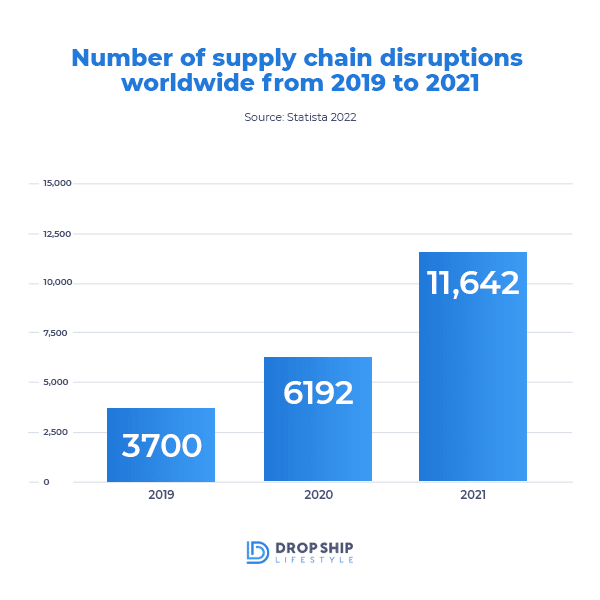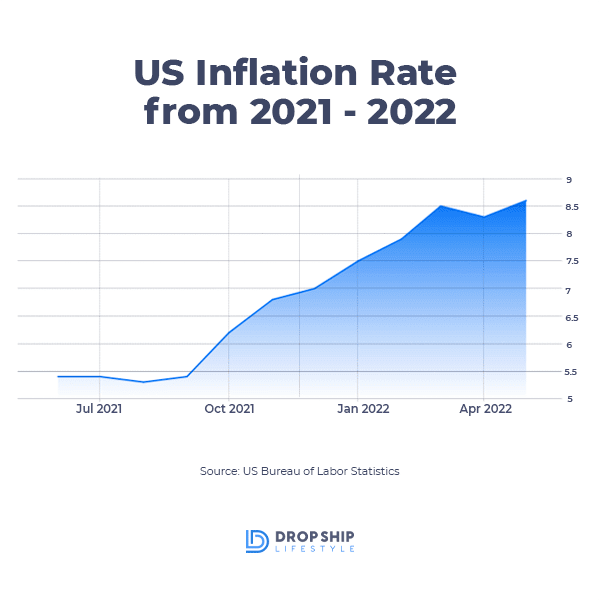If you’re in the dropshipping business, you know that the two main factors affecting the industry right now are supply chain issues and inflation. Both have the power to deeply impact businesses, since dropshippers depend on being able to access items, and then being able to sell them for a profit.
This article will explain the root causes of both these problems, as well as provide some insight on how you can best address the situation at hand.
What’s Happening with the Supply Chain?
Covid caused a major upheaval in the supply chain, and people felt the impact of the pandemic worldwide. Although many of those issues had since been resolved, in the past few months, supply chain problems have come to the surface once again.
This is largely due to a recent bout of Covid rearing its ugly head in China. This led to factories closing—and companies being unable to produce and distribute their products. With fewer products coming in from China, many U.S. warehouses are sitting empty. Which made an extremely detrimental impact if you’re selling for a limited number of brands.

In any business, there are factors that contribute to the overall riskiness of the endeavor. In the dropshipping world, being too reliant on too few suppliers puts your business in an especially perilous position. It’s a reality many dropshippers are facing with the latest wave of supply chain disruptions.
The delays in the supply chain have the potential to disrupt almost anyone. If you only work with a few suppliers, today’s climate will put your business at risk for the following:
How to Overcome the Supply Chain Crisis
Businesses don’t exist in a vacuum, and no one is immune to being impacted by world events. However, there are plenty of steps you can take to protect your dropshipping business. These will also ensure that when conditions take a turn for the worse, your business will be able to weather the storm. Here’s how:
1. Diversify Suppliers + Products
If your business has one specific product that sells particularly well, that’s great! However, you need to think about what would happen if you were no longer able to access that one product.
For example, imagine you make most of your profits selling a certain type of leather chair. If something goes wrong with the company that supplies that chair, you could find yourself in real trouble.
To combat this, you should take the following steps:
The more you build up your product offerings, the more sustainable your business will be—regardless of what’s going on in the world.
2. Stay Ahead of Inventory Issues
Once you take steps to diversify your store, there are still things you can do to protect your best-selling items. If you know a certain product is your main profit driver, it’s incredibly important to keep close tabs on your supplier’s inventory of that said product.
You can do this by asking for weekly inventory sheets. In that way, you can have a general idea of what’s available, and look for patterns and trends that may indicate an issue.
If you see that inventory is dipping, you can ask your suppliers to pre-purchase the inventory they have left in stock. However, doing so does require a few things:
Keep in mind that not every supplier is going to agree to this, and there’s a real chance they’re going to say no. Even if they do agree and you’re able to secure their remaining inventory, you still run the risk of selling out of your item before the new shipment comes in.
3. Stop Selling Uncertain Items
If your supplier is running low on products, and you aren’t able to pre-purchase the items you need (or pre-purchase enough of them), the first thing you need to do is see if you can get an ETA on the next shipment.
Sometimes your supplier won’t be able to provide you with a timeline, and this is usually an indication that you should stop selling that particular item.
If you don’t know when something is going to be back in stock, but you continue to sell it to your customers, you risk losing the trust of your clients. Keeping people happy is one of the most important things you can do as a dropshipper. And taking customers’ money for things you don’t know when will arrive is a recipe for disaster.
It’s better to avoid unhappy customers by stopping sales, marking inventory as zero, and halting any paid traffic you may have to that particular product.
The good news is, you can use apps that will notify your customers when you begin selling your item again. So there’s still a chance you can make a sale in the future. It’s also smart to link to comparable products, which is all the more reason why you should diversify your offerings.
In circumstances when the supplier can provide an ETA, you can continue selling the item as pre-orders, as long as you make the details extremely clear to your buyers on your site. That being said, if the ETA is more than a month away, you should probably still discontinue selling.
Another best practice you should implement is even when you put a note with the shipment details on your website, you should still manually email customers who buy items that are back-ordered to confirm they understand and are ok with the delayed timeline.
4. Don’t Let Supply Chain Issues Deter You from Opening a Store
If you want to launch a dropshipping store but haven't yet, don’t let supply chain issues stop you from diving into this incredible business. There will always be obstacles to overcome when you start a business. Starting a store when conditions are tricky can actually help you build a solid foundation.
The key is to follow the advice above and diversify your suppliers, monitor inventory closely, and keep your customers up to date.
You don’t have to wait for the perfect time to start a dropshipping business. As Theodore Roosevelt once said, “Do what you can with what you have, where you are.” It’s a quote that rings true now more than ever.
Get My List of
237 Profitable Product Ideas
Attend my FREE training on how to drop ship
profitable and I'll give you my list of 237 Profitable
Product Ideas completely free!
Attend my FREE training on how to drop ship profitable and I'll give you my list of 237 Profitable Product Ideas completely free!

What’s Happening with Inflation
News about inflation is everywhere. It’s an inescapable fact that the cost of almost everything is on the rise. Even when compared to just six months ago, things cost more money. As disheartening as inflation can be, there are still a plethora of ways you can still succeed as a dropshipper.

An interesting thing to note is that the inflation that’s been occurring has — for the most part — yet to hit the product sector. And that’s not necessarily a good thing.
Many suppliers haven’t changed the price of their products yet. This can be detrimental if you’re working with MAP (minimum advertised price) suppliers—which you 100% should be.
Essentially, MAP enforces a price floor to even the playing field for sellers, but if the price of goods doesn’t increase, neither will the MAP. With inflation, even though the price of goods hasn’t gone up yet, the price of things like shipping and ads has increased, so you’re still losing profits.
Suppliers raising their prices is actually going to be a good thing because they’ll have to raise their MAPs as well. And then both you and your competition will have to raise prices.
Since the cost of raw goods is rising, it’s highly likely that suppliers will raise their prices in the next year or so.
How to Combat Shrinking Margins
If you start to notice that you aren’t making as much of a profit as you used to, don’t worry. There are several things you can do to remedy the situation and get your business back in good shape.
Here’s what you can do:
Profitable Business Owners Are Masters of Adaptation
As much as we wish we didn’t have to deal with either of these issues, the reality is they’re a very real part of running a dropshipping business in 2022. However, being a successful business owner means being able to pivot, adapt, and work with the circumstances that are presented to you. By following the advice above, and not letting the situation discourage you, your store can continue making you money while providing you with your dream lifestyle.



Hey Everyone,
As many of you already know I created Drop Ship Lifestyle after selling a network of eCommerce stores and then trying to find a community of other store owners to network with… What I found was a bunch of scammers who promised newbies they would get rich quick by following their push-button systems!
This led me to create a new community along with an online training program that shares how to build a REAL online business.
I’d love to hear what you think… it’s a 2.5-hour training designed to help you drop ship profitably… all for free.
Be sure to click here to check it out and send me your feedback!
If you go through the “How To Start & Grow A Hyper-Profitable Online Store” webinar and still have questions just contact me and I will help you out